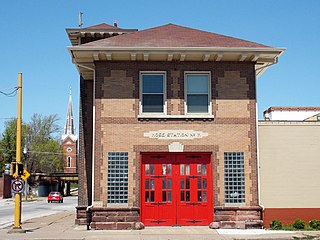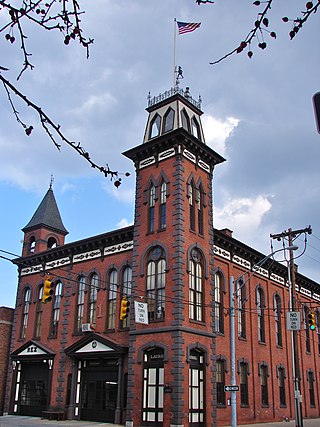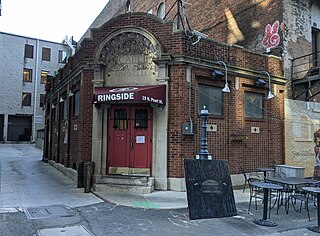
The Hook and Ladder House No. 5 and the Detroit Fire Department Repair Shop are two cojoined structures located at 3400 and 3434 Russell Street in Detroit, Michigan. The Hook and Ladder House No. 5 is the second oldest surviving fire station in Detroit, was designated a Michigan State Historic Site in 1975 and was listed on the National Register of Historic Places in 1997.

Engine House No. 12 is a former fire station in the Olde Towne East neighborhood of Columbus, Ohio. Today it primarily houses Gemüt Biergarten, a German restaurant, brewery, and biergarten, with its second story used for offices. It is a contributing property to the Columbus Near East Side District, a national historic district established in 1978.

The Engine Company 15 Fire Station is located at 8 Fairfield Avenue in Hartford, Connecticut. It was built in 1909, and is one of two surviving firehouses in the city which was built to stable horses. It was listed on the National Register of Historic Places on March 2, 1989. It presently houses Engine Company 15 and Ladder Company 2 of the Hartford Fire Department.

The Andover Hook and Ladder Company Building is a historic fire station at 39 Elm Street in Andover, Maine. It is a long and narrow two-story wood-frame structure. Its front (southern) elevation has a large opening on the first floor closed by a modern garage door on the ground floor, with a small rectangular window to the right. Above this are two widely spaced sash windows. The side elevations each have five sash windows on the second floor; the east side also a single sash window on the first floor. The rear elevation has two sash windows flanking a hose tower that rises above the main, gabled roof. The building is clad in brick-patterned metal (tin) siding which appears to be original.

The Central Fire Station is located in downtown Davenport, Iowa, United States and serves as the headquarters of the Davenport Fire Department, as well as the downtown fire station. Built from 1901 to 1902, the original building is the oldest active fire station west of the Mississippi River. It was individually listed on the National Register of Historic Places in 1982. In 2020 it was included as a contributing property in the Davenport Downtown Commercial Historic District.

The Hose Station No. 7 is located along a busy thoroughfare in a light industrial area of the west end of Davenport, Iowa, United States. It was listed on the National Register of Historic Places in 1983.

The Laurel–Rex Fire Company House, consisting of the Laurel Fire Company's engine house and the Rex Hook & Ladder Company's truck house, is a historic fire station located in York City, York County, Pennsylvania. The oldest building, the Laurel engine house, was built in 1878, and is a two-story, brick building in the Italianate style. The original engine house was expanded in 1887 with a horse stable and in 1892 with a ladder truck house. It has a three-story bell tower on the southwest corner and a second faux tower atop the roof on the northwest corner. It measures 48 by 96 feet.

Hose Station No. 4 is located in the Village of East Davenport in Davenport, Iowa, United States. It is a contributing property of the Davenport Village Historic District that has been listed on the National Register of Historic Places since 1980. The fire station was individually listed on the Davenport Register of Historic Properties in 1993. It is one of two old fire stations on the east side of the city that are still in existence. The other one is Hose Station No. 3. The building sits adjacent to Lindsay Park and now houses the International Fire Museum.

The Ohio History Center is a history museum and research center in Columbus, Ohio. It is the primary museum for Ohio's history, and is the headquarters, offices, and library of the Ohio History Connection. The building also houses Ohio's state archives, also managed by the Ohio History Connection. The museum is located at the Ohio State Fairgrounds, site of the Ohio State Fair, and a short distance north of downtown. The history center opened in 1970 as the Ohio Historical Center, moving the museum from its former site by the Ohio State University. The building was designed by Ireland & Associates in the Brutalist style. It was listed on the National Register of Historic Places along with the Ohio Village in 2023.

The W.H. Bradford Hook and Ladder Fire House is a historic fire station at 212 Stafford Street in Bennington, Vermont, United States. Built in 1893-94, it served for over a century as a fire house for the city, and survived modernizations with much of its historic fabric intact. It has been converted into artist studios and living space. It was listed on the National Register of Historic Places in 1999.

The Toledo and Ohio Central Railroad Station, today named Station 67, is a union meeting space and event hall located in Franklinton, near Downtown Columbus, Ohio. Built by the Toledo and Ohio Central Railroad from 1895 to 1896, it served as a passenger station until 1930. It served as an office and shelter for Volunteers of America from 1931 to 2003, and has been the headquarters of International Association of Fire Fighters Local 67, a firefighters' union, since 2007. The building was placed on the National Register of Historic Places in 1973. During its history, the building has experienced fires and floods, though its relatively few owners have each made repairs and renovations to preserve the building's integrity. The building is the last remaining train station in Columbus.

The Central Ohio Fire Museum is a firefighting museum in Downtown Columbus, Ohio. The museum is housed in the former Engine House No. 16 of the Columbus Fire Department, built in 1908. It was listed on the Columbus Register of Historic Properties in 1983 and the National Register of Historic Places in 1995.

Engine House No. 6, also known as the East Franklinton Engine House, is a former Columbus Fire Department station in the East Franklinton neighborhood of Columbus, Ohio. The building was constructed in 1892, designed in the Romanesque Revival style by John Flynn. The station was decommissioned in 1966, and served as an electronics store from 1975 to 2014. It was listed on the National Register of Historic Places in 2016, accompanying planned renovations. The station has been planned to be sold since about 2016, originally to the Columbus Historical Society and Heritage Ohio, though the latter organization now plans to move to the Ohio History Center. The historical society acquired the building in November 2021, and is restoring it with plans to turn it into the city's first permanent local history museum.
The Columbus Division of Fire (CFD) provides fire protection and emergency medical services to Columbus, Ohio.

Engine House No. 7 is a former Columbus Fire Department station in the Weinland Park neighborhood of Columbus, Ohio. It was built in 1888 and was listed on the Columbus Register of Historic Properties in 1994. Today the building houses a local branch of the Communications Workers of America, Local 4501.

Engine House No. 5 is a former Columbus Fire Department station in the German Village neighborhood of Columbus, Ohio. The building was constructed in 1894, designed in the Richardsonian Romanesque style by John Flynn. The station was decommissioned in 1968. From 1974 to 2002, the space was used for a restaurant and bar, also known as Engine House No. 5. In 2004, the building was converted for office use, and today is the Columbus branch of Big Red Rooster, a marketing company.

Engine House No. 10 is a Columbus Division of Fire station in the Franklinton neighborhood of Columbus, Ohio. The original firehouse was built in 1897, while its neighboring replacement, also known as Station 10, was completed in 2008.

Ringside Café is a restaurant and bar in Downtown Columbus, Ohio. The restaurant is considered the oldest bar or restaurant in Downtown Columbus, having opened in 1897 and operated continuously since then. The restaurant has always been an attraction of politicians, lawyers, reporters, and lobbyists, given its proximity to the Ohio Statehouse, Columbus City Hall, and other government buildings.

Engine House No. 8, also known as the Twentieth Street Engine House, is a former Columbus Fire Department station in the Mount Vernon neighborhood of Columbus, Ohio. The building was constructed in 1888, designed in the Romanesque Revival style. The station was decommissioned in 1968. In the 1980s, a supermarket was built around the original structure; today the firehouse and supermarket buildings are used as the Franklin County Department of Job and Family Services' East Opportunity Center.





















